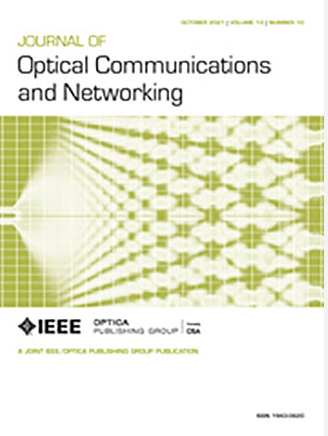通过快速切换波长选择开关和基于段的共享保护实现50 ms光层故障恢复
IF 4.3
2区 计算机科学
Q1 COMPUTER SCIENCE, HARDWARE & ARCHITECTURE
引用次数: 0
摘要
事实上,网络保护是一个公认的话题。然而,利用共享保护容量在光层实现50毫秒的故障恢复一直是电信界的愿望。由于波长选择开关(wss)的重构速度有限,这一目标仍然难以实现。然而,WSS技术的最新进展使10-20毫秒的快速开关成为可能,这使人们对实现这一目标的可行性重新感到乐观。为了实现这一愿景,我们考虑了一种基于段的保护方案——称为共享备份段保护(SBSP)——它利用了快速切换的wss。为了在提出的SBSP框架下有效地分配保护资源,我们首先建立了一个整数线性规划(ILP)模型,使所需的备用容量和最大故障恢复时间同时最小化。此外,我们设计了一种启发式算法,基于虚拟图的SBSP (VG-SBSP),以支持受保护服务的时间约束资源分配。仿真结果表明,VG-SBSP在满足严格的恢复时间约束的同时,所需的保护资源更少,明显优于传统方法。在小规模网络中,VG-SBSP模型的结果接近于ILP模型的最优结果。在大规模拓扑中,VG-SBSP能够在保持低冗余容量的情况下,成功容纳最多的业务。此外,我们还分析了WSS切换速度对SBSP资源分配和服务建立性能的影响。本文章由计算机程序翻译,如有差异,请以英文原文为准。
50 ms optical-layer failure recovery via fast-switching wavelength-selective switches and segment-based shared protection
Indeed, network protection is a well-established topic. However, achieving 50 ms failure recovery in the optical layer using shared protection capacity has long been an aspiration in the telecommunications community. This objective has remained elusive due to the limited reconfiguration speed of wavelength-selective switches (WSSs). Recent advancements in WSS technology, however, which enable fast switching on the order of 10–20 ms, have renewed optimism regarding the feasibility of achieving this aspiration. To make this vision a reality, we consider a segment-based protection scheme—termed shared backup segment protection (SBSP)—that leverages fast-switching WSSs. To efficiently allocate protection resources under the proposed SBSP framework, we first formulate an integer linear programming (ILP) model that jointly minimizes both the required spare capacity and the maximum failure recovery time. Additionally, we design a heuristic algorithm, virtual graph-based SBSP (VG-SBSP), to support time-constrained resource allocation for protected services. Simulation results demonstrate that VG-SBSP significantly outperforms traditional approaches by requiring fewer protection resources while satisfying stringent recovery time constraints. In the small-scale network, VG-SBSP achieves near-optimal results closely matching those of the ILP model. In large-scale topologies, VG-SBSP successfully accommodates the highest number of services while maintaining low spare capacity redundancy. Furthermore, we analyze the impact of WSS switching speed on the resource allocation and service establishment performance of SBSP.
求助全文
通过发布文献求助,成功后即可免费获取论文全文。
去求助
来源期刊
CiteScore
9.40
自引率
16.00%
发文量
104
审稿时长
4 months
期刊介绍:
The scope of the Journal includes advances in the state-of-the-art of optical networking science, technology, and engineering. Both theoretical contributions (including new techniques, concepts, analyses, and economic studies) and practical contributions (including optical networking experiments, prototypes, and new applications) are encouraged. Subareas of interest include the architecture and design of optical networks, optical network survivability and security, software-defined optical networking, elastic optical networks, data and control plane advances, network management related innovation, and optical access networks. Enabling technologies and their applications are suitable topics only if the results are shown to directly impact optical networking beyond simple point-to-point networks.

 求助内容:
求助内容: 应助结果提醒方式:
应助结果提醒方式:


